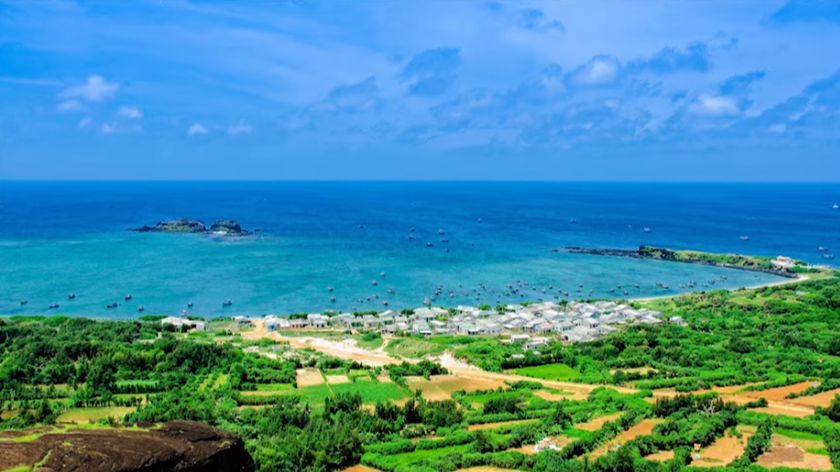In the recent 2024 election, the Maldives has firmly secured the top position in the ranking of the most beautiful islands in the world. This country, with nearly 1,200 large and small coral islands, attracts tourists with its stunning white sandy beaches, crystal-clear waters, and luxurious villas. However, it is natural that enjoying the rare natural scenery here comes at a high cost. On average, to fully experience the Maldives for four days, you will have to spend between 70 to 100 million VND. It is indeed a trip for the wealthy.
However, perhaps we Vietnamese do not need to go far with such a large amount of money, as right in our own country, there is a miniature Maldives that is not much different from the real one. So where is it? It is the most remote island district of Binh Thuan province, Phu Quy Island.
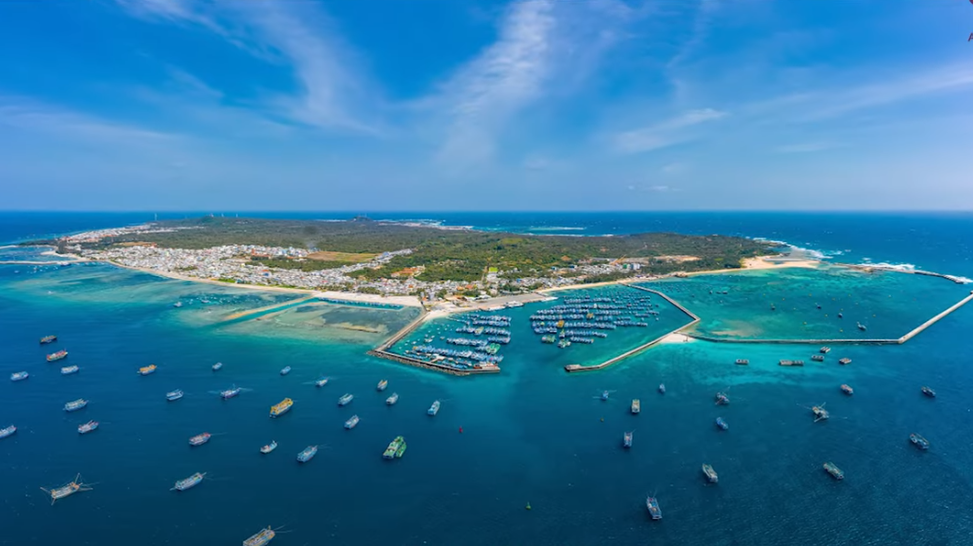
To be more precise, this is an archipelago consisting of 12 large and small islands, including the main island of Phu Quy and the smaller islands named Hon Tranh, Hon Trung, Hon Trung Nho, Hon Den, Hon Do, Hon Giua, Hon Hai, Hon Do Lon, and Hon Do Nho. The largest island is popularly called Hon Thu or Cu Lao Thu because its shape resembles a mackerel, which is Phu Quy Island. Phu Quy Island is located 56 nautical miles, about 120 km, from Phan Thiet port, near international waters, and is the closest island to the Spratly Islands, being 540 km northwest of Song Tu Tay Island. Phu Quy stands out like a bright gem due to its rare tranquility and rustic charm, along with its beautiful location right next to the poetic Trieu Duong Bay.
When visiting Phu Quy, the first destination is Trieu Duong Bay, a place likened to a paradise on a remote island with endless white sandy beaches and a landscape as beautiful as a romantic natural painting, full of colors. This is a favorite bathing spot for locals and tourists from afar. On the shore, there are casuarina forests providing shade, creating a beautiful and poetic landscape that is very suitable for tourists to camp and have fun. The island's highlight is its pristine, peaceful scenery with mountains, sea, grass, and fresh nature, especially on sunny days, allowing you to swim freely in the cool water.
Ganh Hang boasts a wild beauty with rough cliffs standing tall by the sea, shaped in various forms due to the volcanic activity that left its mark. Ganh Hang is one of the beautiful beaches of Phu Quy, with a crescent shape and rocky outcrops jutting out into the sea. The waters of Ganh Hang are clear, with few boats anchored, and the fresh air makes it an ideal place for you to immerse yourself in nature. Phu Quy also features a prominent location, which is the Vô Cực Lake, located in the vast blue space of the sea, created from a natural water gap near Ganh Hang, resembling an S-shaped island.
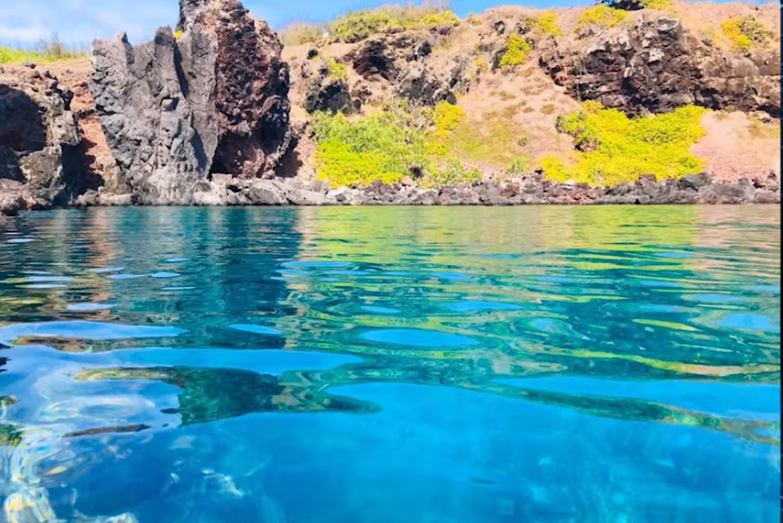
Hon Tranh is located about 800 meters southeast of Phu Quy Island. Hon Tranh is the largest island and also the most attractive destination among the more than 10 large and small islands of Phu Quy district, due to its stunning scenery and diverse ecosystem. Surrounded by high mountains that block the wind, the sea around Hon Tranh is extremely calm and tranquil all year round. Additionally, Hon Tranh possesses a colorful natural coral reef system, allowing visitors to immerse themselves in the clear waters while admiring the masterpieces of nature.
Dreamy travelers cannot miss the Phuot Slope, also known as the April 27 road in Phu Quy. This coastal road features picturesque landscapes with mountains on one side and the sea on the other, along with casuarina forests that seem to reach up to the blue sky. For tourists who love giant windmills from Europe, they must admire the different versions of them at Phu Quy wind farm. Unlike other colorful wind farms, the wind farm in Phu Quy consists simply of pure white turbine poles, yet they stand out against the blue sky and the lush green grass below.
One of the most famous destinations on Phu Quy Island is Cao Cat Mountain. Cao Cat Mountain rises about 106 meters above sea level and is located in the northern part of the Phu Quy archipelago. It features towering cliffs that stretch over 1 km, reaching heights of up to 70 meters, creating a very impressive landscape. Therefore, Cao Cat Mountain is dubbed the Grand Canyon of Vietnam. With its unique schist rock formation from geological activities millions of years ago, Cao Cat has created unique natural landscapes that attract both scientists and tourists.
In addition, this mountain is also commonly referred to by locals as the sea dragon, where the peak of the mountain represents the dragon's head and the tail extends to the teacher's grave. Tourists can easily see the overall area of Cao Cat Mountain from a distance.
One of the outstanding masterpieces created by the volcano on Phu Quy Island is Hon Hai, also known as Hon Kham, which is called Hon Hai because it resembles a shoe. Located 35 nautical miles south of the main island, it is marked on international maps as Polo Sabate. Hon Hai serves as the baseline A6 for calculating Vietnam's territorial waters in the East Sea. The island has an area of 46,000 square meters, with vertical cliffs rising over 100 meters, making it look like a giant fish struggling in the ocean from above. Hon Hai was formed from volcanic eruptions millions of years ago, with the nearest lava encountering the sea and solidifying, while the upper part is more porous and softer, often eroded, leading to frequent rockfalls and collapses over millennia, with wind and sea waves sculpting the rocks into thousands of undulating ridges around the island, resembling a work of art.
Thanks to its advantageous location amidst the vast sea and sky, surrounded by unique limestone cliffs, Bánh Xe Lake possesses a natural scene that captivates many. The name Bánh Xe Lake comes from the fact that there is a wheel located at the bottom of the lake, with many stories passed down about why this wheel is at the bottom of the lake. Although not yet verified, it sounds reasonable, so the locals still believe it. Since 2021, Bánh Xe Lake has gradually become more known to tourists, in a place that feels like a precious gem hidden in the wild nature, making visitors unable to resist its charm.
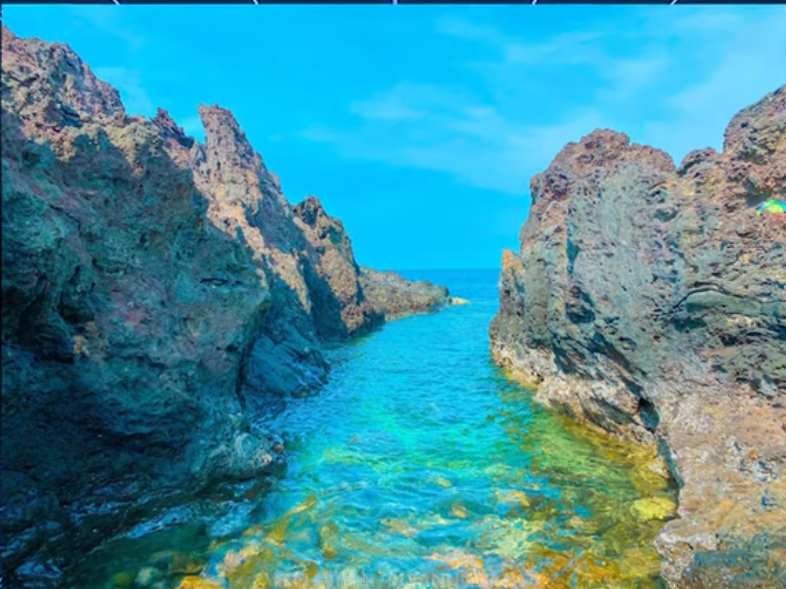
True to its name, khe sung sướng brings visitors a refreshing and relaxing feeling as they immerse themselves in the cool, clear water. The water here is so transparent that you can see the bottom, along with the majestic cliffs standing tall on both sides, creating an incredibly impressive natural landscape. Today, wherever you go on Phu Quy Island, you will encounter the red basalt soil, which are remnants of a long-ago volcano.
According to the locals, just 100 years ago, this place witnessed a geological event that shook the heavens and caused landslides, which was the last volcanic activity in Vietnam. Specifically, from February to March 1923, local people saw a column of smoke and fire erupting, accompanied by loud explosions offshore from Phu Quy archipelago. According to folklore, at the end of the lunar year, when the sky was calm and the sea was quiet, suddenly the island shook, causing many people to feel seasick, and everything swayed, with houses and trees tilting. The people of Phu Quy were terrified and ran to find shelter, thinking that the sky was about to collapse. They saw a column of smoke and fire erupting, accompanied by loud explosions offshore from Phu Quy archipelago. It was truly a unique sight in this sea area, with aftershocks reaching as far as Phan Thiet.
On March 8 of that year, the volcanic eruption occurred but was weak. On March 15, 1923, the volcano temporarily stopped erupting. By March 20, 1923, it erupted again for the last time, creating an island that the people of Phu Quy called Hon Tro. However, just three months later, Hon Tro disappeared; scientists believe that Hon Tro may have been washed away by storms because it was formed from volcanic products that had not yet solidified tightly. Therefore, Hon Tro is also referred to as a fleeting island. Today, Hon Tro only exists in folklore and scientific documents. The sovereignty flagpole of the Fatherland on Phu Quy Island is an indispensable destination in the journey to explore the Pearl Island of Phu Quy, built at the eastern tip of Chuoi Hill.
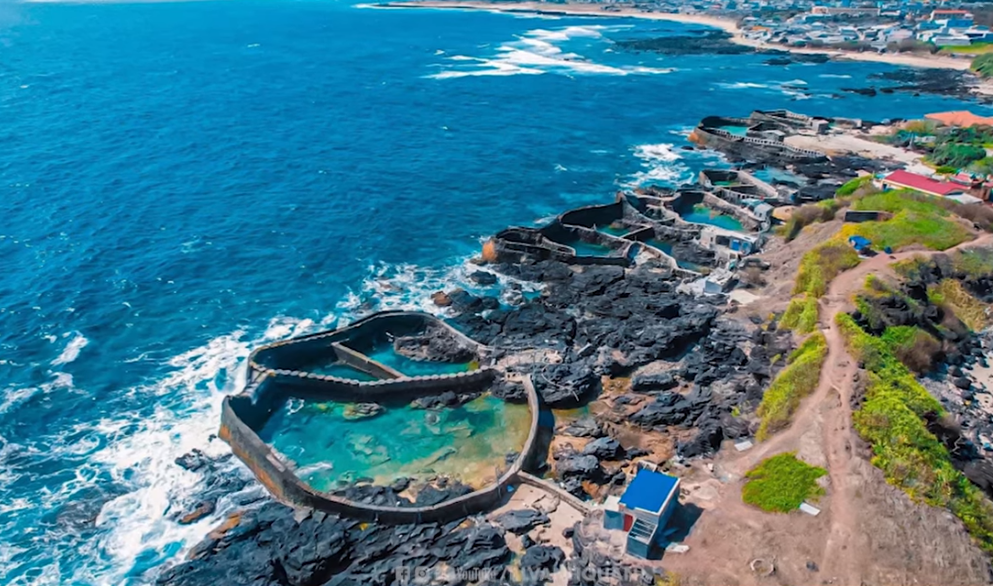
Below is Ganh Hang beach, facing the sea, the flagpole is decorated with the red and yellow star flag, the national emblem, the national name, and the geographical coordinates of the flagpole. The Phu Quy flagpole represents Vietnam's sovereignty over the island while igniting love for the homeland and the responsibility to protect the sacred sovereignty of the sea and islands of the nation. Tourism in Phu Quy is still not fully developed, so entertainment services here are gradually being formed. In addition to swimming, fishing, and snorkeling, Phu Quy has also added adventure services such as sub climbing, paragliding, and experiencing a day as a fisherman, which is a good thing as this island, dubbed the Maldives of Vietnam, still retains many untouched features that captivate many tourists.
Although it cannot be compared to the Maldives in terms of beauty and fame, if you have not had the opportunity to set foot in the land at the far end of the Indian Ocean, Phu Quy will be a wonderful choice that is both close and much more affordable.
